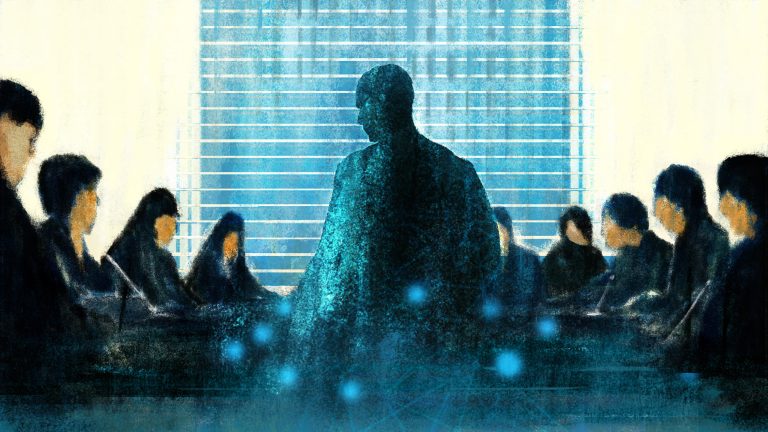Like last year, the majority of the entries in our 2024 photography contest captured on-the-ground realities of how technology is transforming lives in every corner of the world. We received submissions from over 45 countries, showcasing a stunning variety of perspectives on the intersection of technology and daily life. Beyond striking visuals, the photographs tell us stories of how tech plays a role in local communities, from iris-scanning payment systems inside refugee camps to EV battery-powered music gatherings.
The 227 entries we received from contestants — including from Mongolia, the Philippines, Argentina, and Jordan — not only celebrate these stories but reaffirm our commitment at Rest of World to challenge stereotypes about how people use technology in their daily lives.
Here are the top three winning photographs, and six honorable mentions from our 2024 photography contest.
Grace Yoon
🇺🇸 United States
First place

U.S. Customs and Border Protection (CBP) officials collect facial scans from migrants crossing into the country from the U.S.-Mexico border as part of processing procedures. The officials separate men and women at a makeshift camp where passports, bags, and other belongings are scanned. As part of the processing, the men are instructed to remove all but one layer of clothing, even as temperatures drop in the evenings.
Since 2023, CBP used a mobile app for asylum seekers to submit biometric data before they enter the United States. After they make the crossing into the U.S., migrants are subjected to further data collection, including DNA samples. The CBP app was discontinued this week.
Saumya Khandelwal
🇮🇳 India
Second place

Arti Kumari, 24, makes notes while listening to online videos to prepare for upcoming government examinations, while taking care of her newborn at her village home in Bihar. Unable to join in-person classes as she tries to balance household work and child care, she has resorted to online videos to prepare for the exam — her only hope of having a career.
Claire Thomas
🇲🇳 Mongolia
Third place

Children gather inside a tent in the Siberian taiga of northern Mongolia to watch a documentary about a Norwegian reindeer herder who visited the region to learn about the lifestyle of the nomadic Dukha reindeer herders. The tent is located deep in the taiga — a mountainous, subarctic forest that begins where the tundra ends — accessible only by horseback or reindeer. Despite the remote and isolated location, modern technology such as solar panels, car batteries, and the occasional Wi-Fi connection allows these families to stay connected with the world.
Danilo Victoriano
🇵🇭 Philippines
Honorable mention

Two young people play basketball under the towering blades of the windmills in Bangui. The windmills lie along a 9-kilometer (5-mile) shoreline of Bangui Bay, facing the South China Sea. Renewable energy has transformed this community, cutting household expenses and powering opportunities once thought to be out of reach.
Sandra Singh
🇮🇹 Italy
Honorable mention

A group of refugees is photographed a few minutes after landing on the Italian island of Lampedusa, the closest part of the European Union that can be reached via a perilous boat journey from Libya or Tunisia. The Mediterranean Sea is the deadliest migration route for those fleeing persecution and poverty in their home countries. Upon their arrival, these refugees borrowed a smartphone from a bystander and started a video call to let their relatives know they survived the journey. Their own phones had either been soaked during their crossing or had run out of battery during the long days spent on the sea.
Olayide David
🇳🇬 Nigeria
Honorable mention

Two individuals in the Nigerian city of Osogbo dress up in traditional African attire, known as aso oke, and wear goggles crafted from repurposed VHS tapes — a resourceful adaptation of obsolete technology, reimagined as a tool of cultural expression through design and fashion.
The goggles signify more than a practical reuse of materials; they represent how individuals and communities reclaim and reinterpret technology for art, commentary, and resilience. This practice reflects a community’s ability to find new life in what others might discard, highlighting a deep relationship with both old and new technologies.
Harriet Barber
🇦🇷 Argentina
Honorable mention

The Salinas Grandes is the largest salt flat in Argentina, a biodiverse ecosystem stretching over 320 kilometers (200 miles) and sitting within the “lithium triangle” along with parts of Chile and Bolivia. Lithium is an essential component in mobile phone and electric car batteries, and global demand is expected to grow more than fortyfold by 2040.
Antonio Calpanchay has worked this land since he was 12, chopping and collecting salt, replenishing it for the seasons ahead, and teaching his children to do the same. “They started looking for lithium there in 2010,” he said. “We made them stop; it was hurting the environment and affecting the water. But now they are back and I am afraid. Everything we have could be lost.”
Bradley Secker
🇯🇴 Jordan
Honorable mention

A Syrian boy pays for his shopping using an iris scanner at a supermarket, run jointly by the World Food Programme and the U.N. High Commissioner for Refugees, inside the Azraq refugee camp in Jordan. Eye-scanning is a new technology being implemented by the UNHCR and other U.N. agencies to ensure people use only their own credit and not borrowed or stolen cards. After having their iris scanned, Syrian refugees living in the camp can make use of services such as health care and shopping, using just their eyes.
Somenath Mukhopadhyay
🇮🇳 India
Honorable mention

A young boy carries a solar panel down from the roof before the sun sets in a remote village in Jharkhand, India. Many of the rural homes in tribal Jharkhand hamlets that do not have electricity are provided with free solar panels. This has helped local people charge their mobile devices, and children with their studies, along with meeting other basic community needs.



